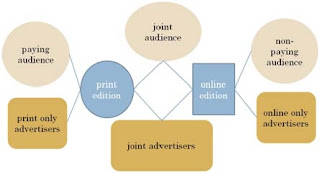The desire to monetize online news is leading some to enthusiastically promote micropayment systems. A number of the leading newspaper sites are leaning toward a cooperative payment system that will allow readers to use a single account to access material at the leading papers. Such a system will not be technically difficult to implement, but getting the price right will be a significant challenge because of transaction costs and significant differences in the economic value of articles.
To create the best industry wide effects, a micropayment payment system would need to include as many papers as possible (see "The Challenges of Online News Micropayments and Subscriptions"
http://themediabusiness.blogspot.com/2009/05/challenges-of-online-news-micropayments.html). The fact that a consortium is currently being sought only among the major players illustrates, however, that such a system would be cost inefficient because content from smaller papers would attract fewer transactions and be more expensive to service.
A widely inclusive system would encounter the problems of small payouts that have plagued collecting rights societies for authors, composers, and performers. Those systems have found that the costs of managing transactions, accounting and auditing, and conveying funds to rights holders incur higher expenses than the payments due many rights holders and that such a system is possible only when the rights holders and content that generate the most transactions subsidize those that generate the least.
This occurs because each right must have a separate account, uses of all rights must be monitored and recorded, funds must be collected, expenses for accounting, auditing and other administrative costs paid, and funds must be transferred to recipients. These activities incur significant transaction costs.
Even a cooperative system limited to newspapers that attract the largest number of customers will encounter transaction cost challenges.
In single content sales systems, for example, the cost of making transactions takes up the bulk of the price. In the sale of mobile telephone ringtones, for example, the composer, arranger, and performer get only about 20% of the price. For digital song downloads everyone associated with the content--songwriter, arranger performers, and record company--receive less than half. This occurs because merchant and financial transaction costs are very high. The cost for using a credit card adds 5 to 7 percent to merchant costs and the expense for bank processing of each transaction is a minimum of about 25 cents. Even electronic fund transfers between bank accounts incurs about 30 cents in transaction costs.
These realities will affect the structure and pricing of newspaper article micropayment purchases. The most efficient system for users and firms will require the use of prepaid customer accounts to reduce the number of bank system transactions. This will allow users to transfer funds to their accounts and then purchase articles at pennies a piece. Funds collected would be then periodically transferred to papers. Such a system could also include the option for occasional users to make credit cards purchases of articles, but the price would have to be $2 to $10 per article to make it worth the effort.
The biggest pricing challenge, however, is that some articles will be more valuable than others and will be most sought after by consumers. This means newspapers will have to figure out BEFOREHAND which stories fall into those categories and they will have to decide what prices to charge for them. Papers will have to hire personnel to try to figure out before publication which are the most economically valuable stories--something that will be extremely hard to do--or they will have to set prices based on the costs invested in creating each story (something current newspaper accounting systems do not support). In either case, increased costs will result. The only other reasonable option is to set prices per article based on the overall average cost of producing an article or a column inch of editorial copy. This, of course, over and under prices content simultaneously.
Moving to a micropayment system is not merely a matter of starting to charge for content online, but involves changing the fundamental business model of papers. Newspapers have historically bundled all content into one product available at a single price. In retailing, bundling has always worked best for getting consumers to buy more of the product at a lower price than if bought individually. With this tactic the producer gains profit because the costs of distribution and sales are collectively lower. A second tactic involves bundling products of unequal or uneven value that are sold together to achieve a joint price that is higher than would have been obtained individually.
Newspapers have historically benefited from such bundling by filling pages with relatively inexpensive news agency and syndicated content and by including huge amounts of information culled from public sources that did not require significant investment of resources or added value. Unbundling and selling individual articles with a micropayment system will produce little consumer willingness to pay for this type of content--a significant problem because it is the bulk of editorial content in most newspapers today. Unbundling will also increase transaction costs, thus reducing profitability. This will force higher prices on consumers that will affect demand.
Disaggregating the newspaper and making more money off some individual articles will also create pressure for additional payments from journalists who write the most valuable articles. This will also increase costs of the micropayment system.
Making money from online journalism is, thus, not just a matter of saying "Let's all start charging." It will require fundamental rethinking of the value chain, what content is offered, and how it is produced. It will also require significant thought about what's in it for consumers--something that is glaringly missing from current discussions of starting online payments. The consumer challenge is especially salient because most online news readers do not currently buy newspapers. If they are not willing to pay for news in print, why will they suddenly be willing to pay for that same news online? If papers can't figure that out, no decision to implement micropayments will end happily.
